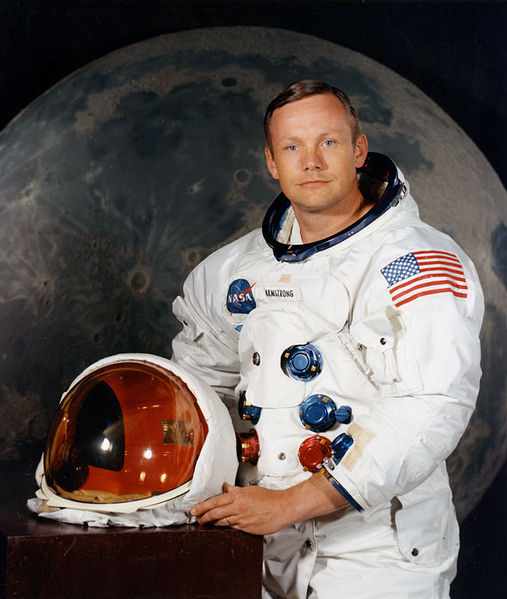Neil Alden Armstrong (Neil Alden Armstrong)

American Astronaut. He was the mission commander of the Apollo 11 manned space flight to the Moon. On July 20, 1969, he became the first person in recorded human history to walk on the moon, before being joined on the lunar surface by fellow astronaut Edwin “Buzz” Aldrin. Viewed by a global audience of over 600 million people, he stepped foot on the lunar surface at 10:56 pm EST, saying “That’s one small step for [a] man, one giant leap for mankind.” Trained as an aerospace engineer at Purdue University and the University of Southern California, he served as a United States Naval Aviator during the Korean War, completing 78 combat missions. Following the war he joined the National Advisory Committee for Aeronautics as a test pilot, at the high speed flight station at Edwards Air Force Base in California. As a test pilot, he flew America’s most advanced military aircraft including the F-100 Super Sabre, the F-101 Voodoo, the Lockheed F-104A Starfighter, the B-47 Stratojet and the North American X-15. In 1957 he was recruited into the U.S. Air Force’s Man in Space Program, and in 1962 he was selected as part of the National Aeronautics and Space Administration’s (NASA) second group of astronaut trainees. He flew his first space mission in March 1966 as commander of Gemini 8, successfully rendezvousing and docking with an unmanned orbital spacecraft. In December 1968 he was selected as the commander of the Apollo 11 moon mission, and was teamed shortly thereafter with Michael Collins and Edwin Aldren as part of the official flight crew. On July 16, 1969, Apollo 11 began its four day, 250,000 mile journey to the moon, culminating in Armstrong’s and Aldren’s lunar landing, and historic moon walk. Following the Apollo 11 moon mission, he served briefly as the Deputy Associate Administrator for aeronautics for the Office of Advanced Research and Technology. He resigned from NASA in August 1971, to accept a teaching position as a professor of aerospace engineering at the University of Cincinnati where he remained until 1979. He was appointed to the Rogers Commission by President Ronald Reagan in 1986, following the Challenger space shuttle disaster, serving as vice-chairman. Returning to civilian life following his retirement from NASA, he served as a commercial spokesman for the Chrysler Corporation, and also served on several boards including Learjet, United Airlines, Marathon Oil, the Eaton Corporation and Taft Broadcasting. He was the recipient of the Presidential Medal of Freedom (1969), the United States Military Academy’s Sylvanus Thayer Award (1971), the Congressional Space Medal of Honor (1978), the Congressional Gold Medal (2009) the Korean Service Medal and Air Medal. He was an inductee into the Aerospace Walk of Honor in 1991 and the United States Astronaut Hall of Fame in 1993. The Neil Armstrong Hall of Engineering on the campus of Purdue University, the Neil Armstrong Air and Space Museum in Wapakoneta, Ohio, the lunar crater Armstrong and asteroid 6469 Armstrong are all named in his honor. In 2005 his authorized biography “First Man: The Life of Neil A. Armstrong” was published and released to the general public. (bio by: Nils M. Solsvik Jr.) Family links: Parents: Stephen Koenig Armstrong (1907 – 1990) Viola Louise Engel Armstrong (1907 – 1990) Children: Karen Anne Armstrong (1959 – 1962)* *Calculated relationship
Born
- August, 05, 1930
- USA
Died
- August, 08, 2012
- USA
Other
- Cremated

